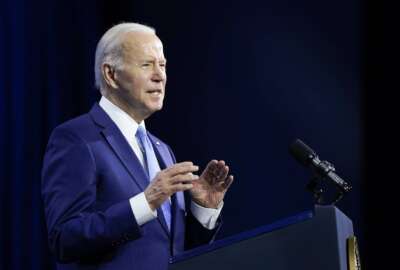Hubbard Radio Washington DC, LLC. All rights reserved. This website is not intended for users located within the European Economic Area.
On Air: Federal News Network
Trending:
Hard to tell how much impact EO will have on federal pay equity
Executive Order 14068 directs OPM to issue a proposed rule on using salary history in the hiring and pay-setting processes for federal employees.
Updated on March 28, 2022, with a comment from the DOJ Gender Equality Network.
American employers tweeting messages of support for gender equality on International Women’s Day this month were largely spared the embarrassing retweets of the U.K.-based @PayGapApp Twitter bot.
Because companies in Britain with 250 or more employees are required to publish their average pay for men and women, this made it easy for the bot to point out pay inequities at the businesses who tweeted hashtags like #IWD2022 or #BreakTheBias starting March 8.
But really, the U.S. federal government could qualify for a retweet, as women in government earned about 7% less than their male colleagues as of 2017, according to a report by the Government Accountability Office in December 2020.
President Joe Biden used this year’s Equal Pay Day on March 15, which marks how far into the year women would have to work to earn the same as men did in the previous year, to sign Executive Order 14068. The EO directs the Office of Personnel Management to issue a proposed rule on using salary history in the hiring and pay-setting processes for federal employees. The directive echoes the president’s June EO on diversity, equity, inclusion and accessibility, especially as it pertains to federal procurement.
That same day, the Office of Federal Contract Compliance Programs issued a directive requiring supply and service contractors to conduct pay equity audits and look for gender-, race-, or ethnicity-based disparities.
Neither the EO nor the OFCCP directive prohibit the use of salary history in hiring practices for federal employees and contractors, which is what some feds say is truly needed to close the gender pay gap. Two years ago, a coalition of affinity groups at the Justice Department wrote a letter to the agency’s leaders calling on DOJ to stop asking for salary history in its hiring process. The letter said that several employees who joined DOJ between 2012 and 2018 saw salary history as a required information field in USA Jobs descriptions, and that this often resulted in inequitable pay disparities compared to male and/or white counterparts.
In addition, DOJ’s job posting for its own chief diversity officer, a new role created under the DEIA executive order, asked for candidates’ salary history under “Required Documents.”
Relying on a person’s salary history, which may be the result of systemic inequities in compensation for women and people of color, to set their new salary in government will further pay inequities, the DOJ Gender Equality Network argues.
“Stamping out pay inequities means banning the consideration of salary history at every stage of the hiring process. Merely prohibiting agencies from soliciting it is not enough,” Stacey Young, president of the DOJ GEN and an attorney in the department’s Civil Rights Division, said in an email. “Agencies shouldn’t wait for OPM to issue a salary history ban. They can follow the lead of many states, municipalities and private employers by banning the consideration of past salary now.”
It may seem curious how gender pay gaps can exist under the highly regimented General Schedule. Federal employees are supposed to receive equal pay for equal work, and the GS was designed to pay federal employees based on their experience and skills, not their gender, race, ethnicity or personal connections, as Federal News Network reported.
New government employees often start at the position’s designated GS level and step 1 pay rate, unless the hiring agency can justify placing that new employee at a higher step. In fact, the inherently mechanical nature of the federal pay system is why salary history has not largely mattered in hiring decisions, according to Ron Sanders, chair of the Federal Salary Council from 2017 to 2020 and currently the staff director for the Florida Center for Cybersecurity at the University of South Florida.
The good news is that once a person is in government, pay increases follow the fixed system. The bad news is that new feds coming from private industry, who may enter government at a salary above or below their peers for the same experience, are more likely to stay that way. Systemic inequities are both eliminated and perpetuated, he said.
Unlike government, private industry does not have set rates at which people can be paid for certain jobs. It cannot rely on a generic scale to determine the value of a person’s experience or the cost of labor for a job, but it can see how much you earned at your previous company.
As a former chief human capital officer for the Office of the Director of National Intelligence, who also held multiple roles in human resources at OPM and IRS, Sanders did not think eliminating the pay history question entirely would hobble the government’s ability to negotiate in the hiring process, so long as agencies can still ask about a job candidate’s experience.
Sanders was also of the opinion that merit-based raises were not used enough in federal government, and that politics ends up driving pay raises rather than national and local market rates, or the competitiveness of different fields. This habit leads to poor performers earning as much as higher performers, and certain areas like cybersecurity being underpaid while less in-demand administrative roles are overpaid, he said.
As for contractors, Sanders said salary history could still be important. Contractors need to know their labor costs in order to bid on contracts, and this keeps them tied more closely to market rates. As a side note, workers employed by federal contractors make up about one-fifth of the entire U.S. labor force, according to the Labor Department.
What effect this new OFCCP directive will have Sanders couldn’t say, nor did he predict that merely having the EO would spur agencies to drop salary history from hiring decisions on their own accord.
In its March 15 statement, DOL noted the directive comes nearly 60 years after President Lyndon Johnson signed EO 11246, which prohibited federal contractors and subcontractors under certain circumstances, from “taking adverse employment actions against applicants and employees for asking about, discussing, or sharing information about their pay or the pay of their co‐workers.” It was the first time a Cabinet–level official had the responsibility and enforcement authority to ensure equal opportunity for minorities in federal contractors’ recruitment, hiring, training and other employment practices. It also reinforced that federal contractors could not discriminate in employment, and that they take affirmative action to ensure equal opportunity based on race, color, religion, and national origin.
Yet despite all these safeguards, the gender pay gap in federal government still exists. The GAO report which found a 7% gap between men and women in 2017 also said that disparity was down from 19% in 1999. The report attributed much of the difference to “unexplained factors” like rates of promotion, career choices. GAO is still short on parental leave data, as the 12-week part-time off program for both mothers and fathers did not start until 2020, Federal News Network reported.
OPM does not collect data on parental status, however, which could be a big factor in what jobs women take compared to men, especially when considering the role’s telework or travel flexibility.
The gender pay gap has decreased over time but its persistence to this day is still troubling. In 1960, women earned about 60.7% of what men earned, and in 2020 they earned about 83%. That decline has continued in spite of multiple recessions.

And while March 15 may be Equal Pay Day for women overall, the breakdown of pay gaps by race means different demographics have to wait longer to earn the same as white men. According to the American Association of University Women, Equal Pay Day for Asian American, Native Hawaiian and Pacific Islander women is actually May 3. Black Women’s Equal Pay Day is Sept. 21, Native Women’s Equal Pay Day is Nov. 30, and Latinas’ Equal Pay Day is all the way on Dec. 8 — essentially requiring Latinas to work twice as long as white males to earn the same amount.
OFCCP said pay equity audits are a proactive measure and will make pay systems more transparent. That still doesn’t mean women and people of color who are already on the books at a lower rate than their white and male coworkers will be brought up to comparable salaries. Pay audits could prevent future gaps, but what about fixing existing ones? That is where equity happens.
In his 1965 commencement address at Howard University, shortly after signing EO 11246, Johnson referenced the new Civil Rights legislation using language that may sound familiar to those following today’s national dialogue about equity in America:
“But freedom is not enough. You do not wipe away the scars of centuries by saying now, ‘You are free to go where you want and do as you desire, and choose the leaders you please,’” Johnson said. “You do not take a person who for years has been hobbled by chains and liberate him, bring him up to the starting line of the race and say, ‘You are free to compete with all the others,’ and still justly believe that you have been completely fair.”
Nearly Useless Factoid
Cats spend about 70% of their lives asleep.
Source: Veterinary Hub
Copyright © 2024 Federal News Network. All rights reserved. This website is not intended for users located within the European Economic Area.
Amelia Brust
Amelia Brust is a digital editor at Federal News Network.
Follow @abrustWFED
Related Stories
Explaining the ‘unexplained’ reasons for the gender pay gap in the federal workforce
Related Topics
All News
Biden administration
Commentary
Contracting
diversity equity inclusion and accessibility
DOJ Gender Equality Network
executive order
executive order on diversity equity and inclusion
federal pay raise
Federal Report
Federal Salary Council
gender gap
general schedule
Hiring/Retention
Justice Department
Labor Department
Mike Causey
Office of Federal Contract Compliance Programs
Office of Personnel Management
Pay
Pay & Benefits
pay disparity
pay gap
Ron Sanders
Women In Government
Workforce
Workforce Rights/Governance





